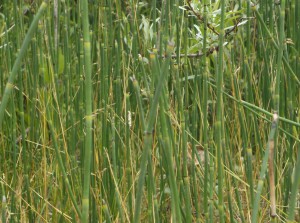
We have all seen them, on the beach or in ditches, but we walk on past them without a thought. If we know them at all, we call them “snake grass” for their banded stems lacking apparent leaves. As kids, we pulled them apart at the joints, noting the empty, hollow canal that runs up the center. Hollow stems suggest many uses to children—whistles, building materials for sand castles, girls’ hair ties, toothpicks, and more. Not having lost the capacity for play, they find much to do with the things we have come to ignore.
Not that all adults ignore them. Campers recognize one species as a choice pot scrubber out in the woods, the scouring rush, Equisetum hyemale. Its stiff ridged stems take grease and dirt of pans without shredding. Players of instruments like the bassoon and oboe prepare their reeds with strokes of the scouring rush and craftsmen in Japan use it for a fine sandpaper.
Snake grass, or horsetails as they are known by many, get their roughness and strength from silica in their stems—you can see the tubercles with a ten-power lens. Some species have more than others: one, the Smooth Horsetail, scarcely has any at all.
The Dutch find value in horsetails, mostly in maintaining the dikes that keep their land dry. The plant has deeply rooted rhizomes (horizontal underground stems) which bind the soil, a helpful aid in reinforcing walls that keep the sea out. A weed anywhere else, it is an asset in Holland.
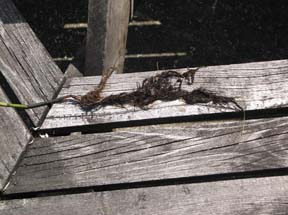
The common name “horsetail” requires explanation since the above-ground parts of the plant in no way resembles any part of the horse’s anatomy. If you have the patience to dig down into the mud out of which the horsetail species known as “pipes” grows (and, I confess, I did just that at some sacrifice of blood to mosquitoes), you can discover how they came to take on the “horsetail” name. The rhizome is jointed just like the stem, and out of each joint a tuft of roots grows–which, in aggregate, look pretty much like a horse’s tail. Perhaps “snake grass” is the more reasonable name given the difficulty with exposing the “tail.”
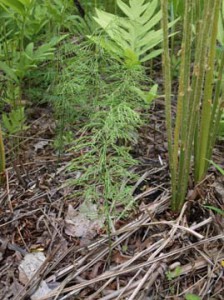
Horsetails are not particularly successful as green plants go: they consist of one family with one genus and only a scant 15 species. Michigan has eight and all of them be found in the Grand Traverse area. Always they seem to prefer wet places—ditches, beaches, swamps, and marshes.
Horsetails were not always the weak sisters of the plant world. Giant members of the horsetail family that reached heights of 45 feet are preserved in the coal beds of Pennsylvania and elsewhere. Before the dinosaurs, before the flowering plants, they dominated the land in variety, abundance, and sheer size. Alas for them, they now grow in neglected places separated from the great ecosystems of hard and softwood forests, plains and desert, tundra and bog.
Seed-producing plants won out in the long run, the conifers, hardwoods, and grasses occupying the greatest stretches of land. Horsetails make spores, those produced in small cones that lie at the tips of the shoots. They drift about in the wind, the luckiest ones arriving at a moist warm place to grow. There they grow into miniscule green bodies that produce eggs in one place and sperms in another. The sperms swim to fertilize the egg—and a new horsetail is born. However, horsetails can avoid the whole process by having a piece of the rhizome break off and root elsewhere.
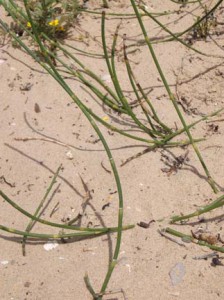
Horsetails—snake grass–are not esteemed by those who wish to keep their beaches well-groomed. Their roots are hard to tear out—remember the Dutch and their dikes?—causing them to reappear after great effort has been exerted to remove them. Still, we should appreciate their good qualities: they scour, they sandpaper, they can be tied. Not only that, they provide a glimpse into a different world 350 million years ago. If you see a millipede hanging out among the stems of horsetails, you might be looking out on a scene enacted 380 million years ago. Horsetails deserve our respect for their venerable age.
Richard Fidler, when not elbow-deep in swamp mud, can be found editing “Grand Traverse Journal”.

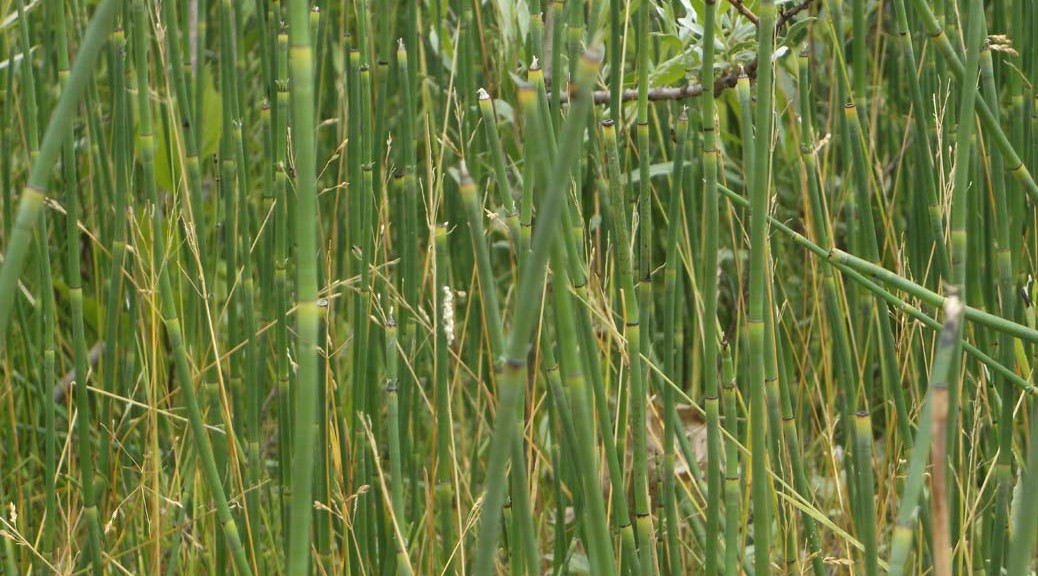
I think I have the common horsetail growing in my first year garden and here and there on my property. How do I get a definite evaluation. I would like to leave it alone with the veggie plants if possible. I live in Saint Helen Michigan and have a pond on my property. Is there somewhere I can send a picture/s to for analysis? Thank you.
Dear Sherry, great question! I recommend contacting your local Roscommon County Michigan State University Extension, as I’m sure they would love to help you identify what is in your gardens: http://msue.anr.msu.edu/county/info/roscommon